By Jesse Colombo (This article was written on April 19th, 2012)
Railway Mania was an economic bubble in the United Kingdom in the 1840s that involved a railroad development frenzy and a speculative bubble in the shares of railroad companies. Like the Dot-com bubble of the late 1990s, the British Railway Mania was the result of overexuberance toward the business prospects of a disruptive innovation; though railroads are now a part of everyday life, they were once every 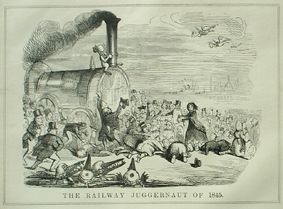 bit as revolutionary as the internet was when it was first introduced. As railroad stocks soared to astounding heights, railroad companies massively overbuilt thousands of kilometers of railway lines throughout the UK. When the Railway Mania bubble eventually popped, many railroad companies went out of business, railway stock investors were ruined and enormous debts were left throughout the country.
bit as revolutionary as the internet was when it was first introduced. As railroad stocks soared to astounding heights, railroad companies massively overbuilt thousands of kilometers of railway lines throughout the UK. When the Railway Mania bubble eventually popped, many railroad companies went out of business, railway stock investors were ruined and enormous debts were left throughout the country.
Events Leading Up to the Railway Mania
The UK’s Industrial Revolution was well underway by the 1840s and the resulting surge in industrial activity required a more efficient means of transporting increasingly large quantities of coal, iron ore and other raw materials and finished goods. The country experienced economic growing pains as traditional horse-drawn vehicles and the Bridgewater Canal in the northwest were already proving inadequate for the demands of the Industrial Age.
The UK’s earliest railroad technology shared little resemblance to the railroads of today or even one-hundred years ago – it consisted of simple wagons that rode on wooden rails and were used to carry coal and other raw materials over short distances to various waterways for further transportation. The first iron rails were laid in Coalbrookdale in 1767 and the first public railroad was the horse-drawn Surrey iron railway in 1801 (The British Newspaper Archive, n.d.). By this time, “iron roads,” as they were often called then, started to be seen as superior to roads and canals, which were often frozen during winter months, rendering their use impossible. The first steam locomotive was invented by in 1804 by engineer Richard Trevithick and was used to haul coal at a mine. By 1810, there were nearly 300 miles of railroad track in the United Kingdom (The British Newspaper Archive, n.d.).
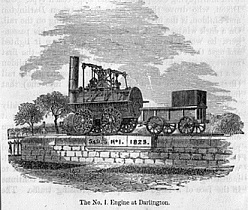 An improved steam locomotive design was built in 1814 by George and Robert Stephenson, a father-and-son team. In 1825, the Stephensons built the first steam-powered railroad for industrialist Edward Pease – the 25-mile long Stockton-Darlington line. Though horses were also used on this line, steam-powered locomotives proved to be far more efficient. The Stockton-Darlington line featured the first modern train, consisting of carriages pulled by a locomotive engine, along with “a locomotive engineer with the engineer and assistants; tender with coals and water; six wagons loaded with coach and flour; a coach with the committee; 21 wagons fitted up for passengers; and six wagons loaded with coals; making altogether a train of 38 carriages, exclusive of engine and tender,” according to the Bath Chronicle.
An improved steam locomotive design was built in 1814 by George and Robert Stephenson, a father-and-son team. In 1825, the Stephensons built the first steam-powered railroad for industrialist Edward Pease – the 25-mile long Stockton-Darlington line. Though horses were also used on this line, steam-powered locomotives proved to be far more efficient. The Stockton-Darlington line featured the first modern train, consisting of carriages pulled by a locomotive engine, along with “a locomotive engineer with the engineer and assistants; tender with coals and water; six wagons loaded with coach and flour; a coach with the committee; 21 wagons fitted up for passengers; and six wagons loaded with coals; making altogether a train of 38 carriages, exclusive of engine and tender,” according to the Bath Chronicle.
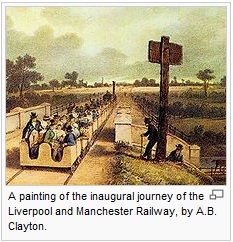 In 1830, Britain (and the world’s) first recognizably modern inter-city railroad opened – the Liverpool and Manchester Railway (L&MR). Crowds of thousands of people gathered for the L&MR’s opening ceremony, including the Duke of Wellington. Though the ceremony was marred by the tragic death of Parliament member William Huskison, who was accidentally hit by the L&MR’s locomotive (the world’s first train-related death), the railroad proved to be highly successful for transporting both passengers and freight (Wikipedia, n.d.).
In 1830, Britain (and the world’s) first recognizably modern inter-city railroad opened – the Liverpool and Manchester Railway (L&MR). Crowds of thousands of people gathered for the L&MR’s opening ceremony, including the Duke of Wellington. Though the ceremony was marred by the tragic death of Parliament member William Huskison, who was accidentally hit by the L&MR’s locomotive (the world’s first train-related death), the railroad proved to be highly successful for transporting both passengers and freight (Wikipedia, n.d.).
The Bubble Phase
An economic slowdown in the late 1830s and early 1840s, high interest rates and anti-railroad protests temporarily slowed the development of railroads as industrialists and investors gravitated toward investing in high-yielding government bonds instead of speculative railroad projects. Soon after, the Bank of England cut interest rates to stimulate the economy and, by the mid-1840s, the UK’s economy was booming again, driven by manufacturing industries. Railroads captured investors’ interest once more thanks to their rising share prices and the increasing demand for transportation of passengers and cargo by train.
The mid-1840s were an extremely fertile environment for the UK’s stock market – and the formation of stock market bubbles. The Industrial Revolution led to a surge in the number of middle class and affluent households, many of which became members of Britain’s burgeoning investor class. New business ventures, including railroads, could now raise capital from the relatively well-educated investor class instead of solely relying upon capital provided by banks, wealthy aristocrats and industrialists, as they had in the past.
Some of the seeds of the Railway Mania were sown back in 1825, when the government repealed the Bubble Act, which was enacted after the South Sea Bubble debacle of 1720 and was designed to regulate the formation of new businesses and limit joint stock companies to a maximum of five separate investors. The repeal of the Bubble Act also allowed the general public to buy shares of stock and allowed companies to heavily promote themselves, abetted by new media such as newspapers.
Railroad companies became some of the most aggressive promoters of their own stock, which they portrayed as a virtually risk-free investment. To further entice investors, railroad companies offered promotional deals on their stock in which they allowed investors to purchase their shares with only a 10% deposit, while the company held the right to call in the remaining 90% of the purchase at any time (Camplin, 2010). Investors soon became enamored with railroad companies’ growth prospects, creating a level of excitement that was similar to the excitement over technology stocks during the initial stages of the 1990s Dot-com bubble.
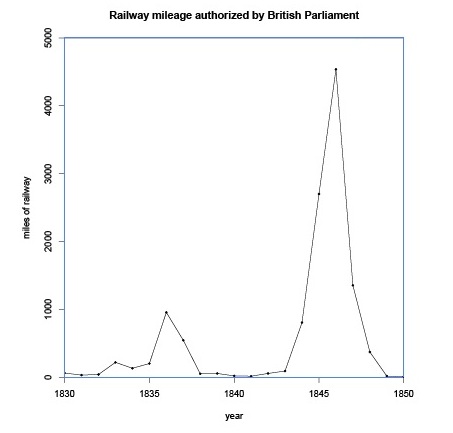 Chart Source: Andrew Odlyzko
Chart Source: Andrew Odlyzko
The British government pursued a virtually laissez-faire approach toward the regulation of railroad development. Though companies were required to submit a Bill to Parliament for approval of new railroad lines, there were no limits on the number of railroad companies and nearly anyone could form a railroad company and submit a Bill to Parliament. Financial viability of railroad lines was not a requirement for Parliament’s approval and most Bills were approved due to the fact that many Members of Parliament were heavily invested in railroad companies – a blatant conflict of interest (The Science Museum, 2004).
As railroad company shares continued to rise, investors became increasingly wrapped up in the speculative fervor and many middle class families invested all of their savings into them. Many famous figures became involved in railroad stock speculation including Charles Darwin, Charles Babbage, John Stuart Mill, the Brontë sisters and Benjamin Disraeli (Odlyzko, 2010). The large amounts of capital that were now available to railroad companies were soon deployed in highly-audacious, impractical and often fraudulent railroad development plans.
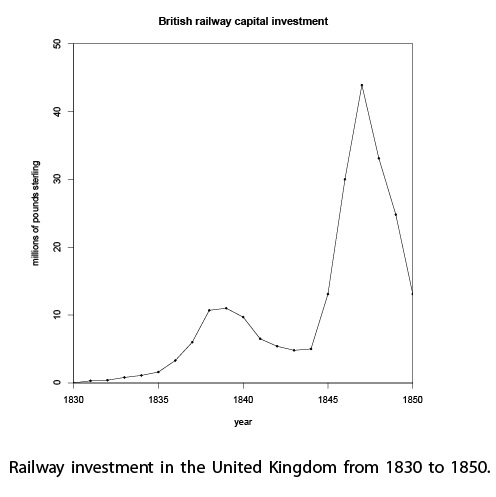 Chart Source: Andrew Odlyzko
Chart Source: Andrew Odlyzko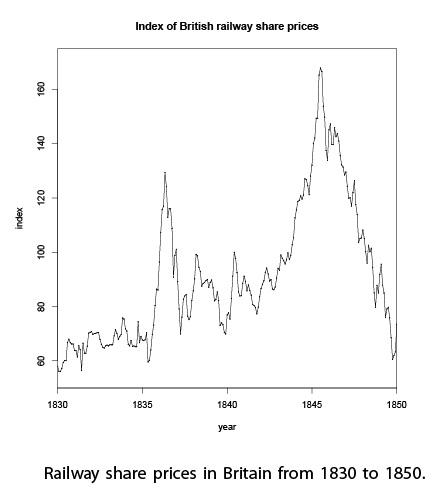 Chart Source: Andrew Odlyzko
Chart Source: Andrew OdlyzkoBy the peak of the Railway Mania in 1845 and 1846, scores of railroad companies were formed and many proposed schemes such as “direct” rail lines that ran straight across the UK’s countrysides, which would be very difficult to build and almost impossible for the locomotives of the time to travel upon. At this point, nearly every town wanted its own railroad and, in 1846, 272 Acts of Parliament were passed for the purpose of incorporating new railroad companies, which proposed a total of 9,500 miles (15,300 km) of new lines (Wikipedia, n.d.). Railroad magnates such as George Hudson developed large rail networks through the acquisition of smaller railroad companies. From 1844 to 1846, an index of railroad company stocks approximately doubled as the speculative mania took hold (Odlyzko, 2010).
The Crash
In 1845, the Bank of England tightened its monetary policy by raising interest rates, which has a tendency to pop economic bubbles as capital is no longer as cheap as it once was and now higher-yielding bonds become more attractive to investors again. Soon after, in 1846, the railroad stock index peaked and began to drop rapidly due to the combination of higher interest rates and growing investor realization that many railroads were not as profitable or even as viable as stock promoters made them appear to be. Railroad stocks proceeded to sink by 50% from 1846 to 1850 (Odlyzko, 2010), a plunge that was exacerbated when railroad companies called in the remaining 90% of the money that they had lent to stock investors as a part of their promotional scheme (Camplin, 2010). Once-comfortable middle class and affluent investors who had sunk their life savings into railroad stocks were financially-ruined after the bubble popped.
The popping of the railroad stock bubble, revelations of widespread fraud and poor financial planning caused a vast wave of railroad companies to fail and abandon their ambitious plans. Nearly one-third of railroads that were authorized by Parliament were never even built (Wikipedia, n.d.). Railroad development slowed considerably in the years following the Railway Mania and the only new lines that were constructed during this time were done so by larger companies. Railroad development continued to grow in the 1850s and 1860s, but nowhere near at the feverish pace of the 1840s.
 Unlike most bubbles, where little value tends to remain after the bubble pops (such as the Dutch Tulip Mania), Railway Mania helped to greatly spur the development of the UK’s railroad system, which became one of the most advanced in the world. In this regard, the UK’s Railway Mania is often compared to the telecommunications bubble of the late 1990s, in which large amounts of fiber-optic cable was laid throughout the world, including deep under the ocean. Although the telecom bubble popped, it left behind valuable communications infrastructure similar to how the Railway Mania left behind valuable transportation infrastructure. In the years between 1844 and 1846, 6,220 miles of railway were built, which remains an important part of the total 11,000 miles that currently exist in the United Kingdom (Barker, & Boden, 1973). Many of the routes that failed after the railroad bubble popped eventually became viable and profitable after they were purchased by large well-managed railroad companies.
Unlike most bubbles, where little value tends to remain after the bubble pops (such as the Dutch Tulip Mania), Railway Mania helped to greatly spur the development of the UK’s railroad system, which became one of the most advanced in the world. In this regard, the UK’s Railway Mania is often compared to the telecommunications bubble of the late 1990s, in which large amounts of fiber-optic cable was laid throughout the world, including deep under the ocean. Although the telecom bubble popped, it left behind valuable communications infrastructure similar to how the Railway Mania left behind valuable transportation infrastructure. In the years between 1844 and 1846, 6,220 miles of railway were built, which remains an important part of the total 11,000 miles that currently exist in the United Kingdom (Barker, & Boden, 1973). Many of the routes that failed after the railroad bubble popped eventually became viable and profitable after they were purchased by large well-managed railroad companies.
Questions? Comments?
Click on the buttons below to discuss or ask me any question about this topic on Twitter or Facebook and I will personally respond:
Related Web Resources:
The British Railway Mania of the 1840s
References:
Barker, B., & Boden, R. (1973). Railway mania. London: Longman.
Bath Chronicle, 6 October 1825, Page 3
Campbell, F. G. (2010). The Railway Mania: Not so Great Expectations? Queen’s University Belfast.
Camplin, B., & Beighton, J. (2010). Railway mania. Middlesbrough: Middlesbrough Institute of Modern Art.
Landow, G. (2005). Railway Mania: The Victorian Web: An Overview. Retrieved on 23rd April, from http://www.victorianweb.org/technology/railways/fraud.html
McCartney, S., & Arnold, A. (2003). The railway mania of 1845-1847: Market irrationality or collusive swindle based on accounting distortions? Accounting, Auditing & Accountability Journal, 16(5), 821-852.
McCartney, S., & Arnold, A. J. (2002). Financial reporting in the context of crisis: Reconsidering the impact of the ‘mania’ on early railway accounting. European Accounting Review, 11(2), 401-417.
Ozlyzko, Andrew. (2010). Collective hallucinations and inefficient markets: The British Railway Mania of the 1840s. Retrieved on June 2, 2012, from,
http://www.dtc.umn.edu/~odlyzko/doc/hallucinations.pdf
The British Newspaper Archive (n.d.). Railway Mania of the 1800s. Retrieved on June 2, 2012, from http://media.britishnewspaperarchive.co.uk/bna-media.php?id=19&ids=76
The Science Museum. (2004). Constructing the railway system: Making the Modern World. Retrieved on 19th April 2012, from http://www.makingthemodernworld.org.uk/stories/the_age_of_the_engineer/01.ST.04/?scene=11
Wikipedia (n.d.). Railway Mania. Retrieved on June 2, 2012, from http://en.wikipedia.org/wiki/Railway_Mania
Williams, A. (1910). The romance of modern locomotion. London: Seeley.

